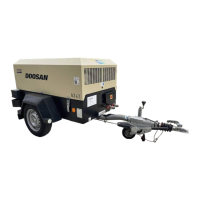What causes oil leakage in my Doosan 7/26E?
- DDaniel FowlerSep 1, 2025
Oil leakage in your Doosan Compressor may stem from a damaged seal or turbocharger seal, loose joints or gaskets, or improper installation of the filter and piping.

What causes oil leakage in my Doosan 7/26E?
Oil leakage in your Doosan Compressor may stem from a damaged seal or turbocharger seal, loose joints or gaskets, or improper installation of the filter and piping.
What causes my Doosan 7/26E to have excessive white smoke?
Excessive white smoke from your Doosan Compressor can be caused by water mixing in the fuel, low compression pressure, incorrect injection timing, low coolant temperature, or a faulty turbocharger.
What causes low engine output in Doosan 7/26E Compressor?
Low engine output in your Doosan Compressor can stem from several issues: incorrect injection pump adjustment (incorrect injection timing), injection nozzle malfunction (incorrect injection pressure), insufficient fuel supply to the injection pump (lack of fuel in tank), air in injection pump, a clogged fuel filter, overflow valve malfunction, or governor malfunction (incorrect engine control adjustment) or deteriorated governor spring. Check for incorrect injection timing, incorrect injection pressure, and lack of fuel in tank.
What causes unstable engine running in my Doosan 7/26E?
Unstable engine running in your Doosan Compressor can result from unstable low idling (possibly due to a crack in the injection pipe), injection nozzle failure, engine stop solenoid return failure, or uneven compression pressure between cylinders. Check for a crack in the injection pipe.
Why is my Doosan Compressor engine burning oil?
If your Doosan Compressor engine is burning oil, it could be due to faulty piston rings or damaged cylinder bores, or a faulty valve stem seal.
What causes excessive fuel consumption in my Doosan 7/26E?
Excessive fuel consumption in your Doosan Compressor can be caused by fuel leakage due to damaged seals, improper component installation or tightening, or excessive injection volume due to a defective injection pump. Check for damaged seals.
What causes my Doosan 7/26E Compressor engine to overheat?
Engine overheating in your Doosan Compressor may be due to a cooling system defect, such as insufficient coolant volume, fan belt slippage, thermostat malfunction, radiator filler cap malfunction, a fouled cooling system interior, or a clogged radiator. Check for insufficient coolant volume.
| Brand | Doosan |
|---|---|
| Model | 7/26E |
| Category | Compressor |
| Language | English |
General safety guidelines and precautions for operating the machine.
Specific safety warnings and procedures for handling compressed air.
Safety precautions and procedures for loading and transporting the machine.
Diagrams and dimensions for machines with fixed and variable height running gear.
Table detailing various physical and performance specifications of the machines.
Specific technical data for the 7/26E, 7/31E, and 7/41 engines.
Steps for initial setup and preparation of the machine before operation.
Step-by-step guide for safely starting the engine and bringing the machine online.
Procedures for safely shutting down the engine and machine, including emergencies.
Schedule outlining periodic maintenance tasks and intervals.
Procedures for regular maintenance tasks and component checks.
Guidelines and specifications for compressor lubrication and fluid selection.
Table of recommended torque values for various fasteners and components.
Wiring diagrams for the machine's electrical systems.
Wiring diagram for the European CE lighting system.
Diagram illustrating the piping and instrumentation of the compressor system.
Table listing engine-related faults, their causes, and recommended remedies.
Table listing compressor-related faults, their causes, and remedies.
Introduction to various optional equipment available for the machine.
Specifications and information for the optional generator unit.
Details on the cold start option to improve winter operation.
Information on the overspeed shutdown valve and its adjustment.
Illustrated external views of the Yanmar diesel engines.
Technical specifications and data for the 3TNV82A, 3TNV88, and 4TNV88 engines.
Schedule for recurring engine maintenance tasks and intervals.
Introduction to parts breakdown and general ordering information.
Instructions and guidance for ordering replacement parts correctly.
